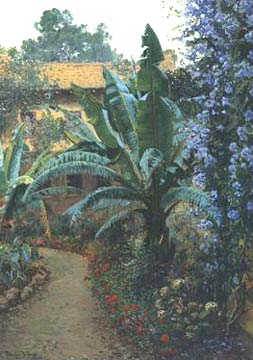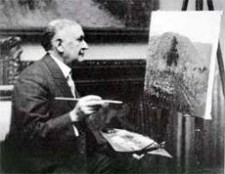
Theodore Wores
American, 1859-1939
Garden of the Potter Hotel, Santa Barbara, 1905 ca.
oil on canvas
35 1/8 x 25 1/8 in.
SBMA, Gift of Ben Shenson, M.D. and Jess Shenson, M.D.
1970.42.2

Undated photograph of Wores painting in the southwest.
RESEARCH PAPER
Most of the early California artists, Virgil Williams, Thomas Hill, Albert Bierstadt, William Keith and C.C. Nahl to name a few, were drawn to the Eden of the West from foreign soils. Theodore Wores was one of the first California artists to be born and trained in his native San Francisco. Though Wores spent a great part of his life traveling in pursuit of the exotic and picturesque, he would continue to return to California and choose its landscape for his plein air paintings. Befriended by such lions of the art and literary world as James MacNeil Whistler, Frank Duveneck, William Merritt Chase and Oscar Wilde, he traversed the artist communities of London, New York and San Francisco and enjoyed continued success throughout his long and flourishing career.
Born in San Francisco ten years after the gold rush in 1859, Wores was an early student to attend the San Francisco Art Association's California School of Design, then under the directorship of Virgil Williams. Encouraged by enthusiastic letters from his contemporary Toby Rosenthal who was studying at the Royal Academy in Munich, Wores enrolled in the Academy in 1875. There under the tutelage of Ludwig Loeffler and Alexander van Wagner, he received a vigorous formal training. While in Munich, Wores joined the American Art Students Club, a group of young men including Chase, Twachtman, De Camp and John White Alexander centering around Frank Duveneck. As one of the "Duveneck Boys," Wores painted en plein air, developing a more expressive brush-shadow. Through his mentor Duveneck, Wores met Whistler while painting in Venice and was entranced by the artist's enthusiasm for Japan.
Returning to San Francisco in 1881, Wores set up a studio next to William Keith on Montgomery Street and painted the captivating exoticism of Chinatown. A fine portraitist, Wores made the acquaintance of the infamous Oscar Wilde through his affiliation with the Bohemian Club; he was commissioned by the Club to paint Wilde's portrait while he visited San Francisco on his American tour. Wores was a popular teacher and was one of the first instructors at the newly founded San Francisco Art Student's League. He also taught studio classes to students in Chinatown.
Though many western artists were influenced by Japanese prints, few had ventured to the Far East. Wores was one of those few arriving in Yokohama in 1885. After several months, he settled on the outskirts of Tokyo. Immersed in the language and the culture of Japan, for two and a half years Wores produced an impressive body of work capturing the beauty of the land and its people. Like the early Taos artists, Wores felt compelled to document on canvas vanishing traditions and did so not only with the peoples of Japan but also of the Hawaiian Islands, Samoa and the American southwest.
Upon leaving Japan, he set up a studio in New York near William Merritt Chase who assisted him with exhibitions of his work from his Tokyo studio. The following year he shipped his work to London taking a studio in Chelsea and enjoyed the friendship of Whistler and Wilde and the high acclaim of the London art public. Packing again in 1892, Wores made his second trip to Japan staying for a year and a half. Returning to the United States, the artist wrote extensively about his Japanese travels, exhibited widely and his lectures were in demand. In 1901 he was one of the first artists of note to travel to the Hawaiian Islands and to Samoa.
In 1906 Wores' San Francisco studio was destroyed in the earthquake while he was painting in southern California. The SBMA owns Garden of The Potter Hotel, Santa Barbara, painted at this time. The following year he returned to San Francisco and became the dean of the faculty and instructor at the San Francisco Art Association's Mark Hopkins Institute of Art. After travels through the Canadian Rockies and the pueblo country of Arizona and New Mexico, Wores established a studio in Saratoga in the 1920's. Disturbed by the new trends in art, Wores rejected modernism and turned his attention to his Garden of Eden, the blossoming fruit orchards covering the Santa Clara Valley floor. Sharing his time between San Francisco and Saratoga until his death in 1939, this celebrated impressionist left behind a visual memory of a California now forgotten.
Compiled for the SBMA Docent Council 2008, LG.

Undated photo of Wores painting in his studio.
